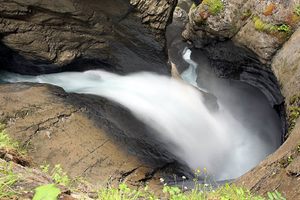
In a beautiful Alpine valley known as the Valley of 72 Waterfalls, Trümmelbach Falls stands out as the only waterfall carved inside the mountains.
While the falls carved their own passages through the rocks, in 1877, Swiss miners began carving additional passages to allow visitors to view the falls from inside the mountain itself. The stairs and walkways tunnel in and out of the rock, alternating underground views with occasional glimpses of the beautiful valley outside.
The powerful cascades come from water melted from the glaciers of the Eiger, Mönch, and Jungfrau peaks, flowing up to 20,000 liters per second.
The rock through which the Trümmelbach has tunneled consists of thick limestone layers. These were deposited as mud in a shallow sea that spread across the entire European continent 140 million years ago, in the Upper Jurassic period. Some 500,000 years ago, glaciers began to excavate the valleys visible today and clear away older rubble.
While other falls in the Lauterbrunnen valley spill freely over the ice-carved cliff faces, the Trümmelbach began to bore into the rock when the valley was still filled with ice. The lateral meltwater from the glacier set in motion a glacier mill that must have functioned for a good part of the last ice age and was fortunately not blocked by moraine debris. The surface meltwater found its way to the glacier floor through this glacier mill hole and then, near Lauterbrunnen, swirled out from under the glacier ice. Trümmelbach Falls have been thundering through the rock for around 15,000 to 20,000 years.
The falls are part of the Jungfrau-Aletsch area, a UNESCO World Natural Heritage Site. Trümmelbach Falls also is listed in the Swiss federal inventory of landscapes and natural monuments of national importance.

